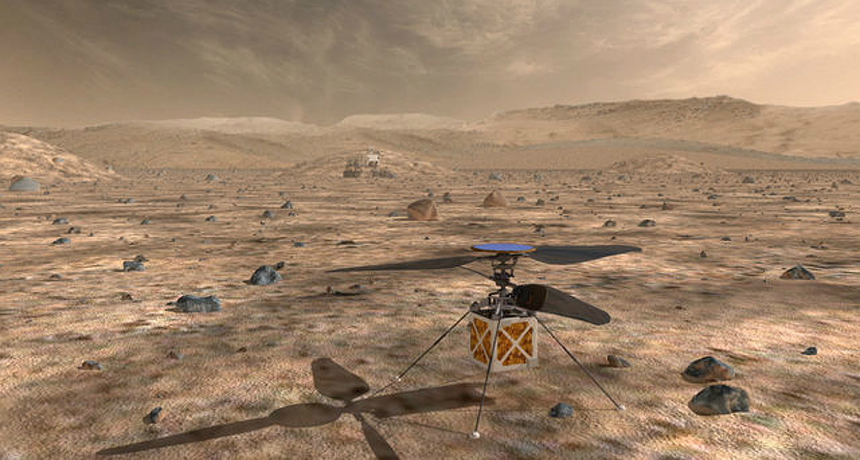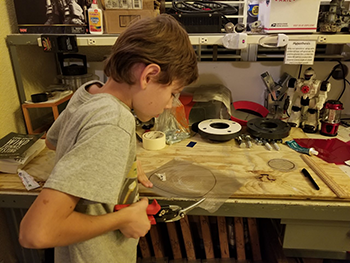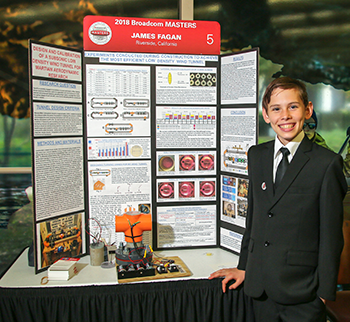Prepping for drone exploration of Mars
Tween builds wind tunnel to test vehicle parts under conditions expected on the Red Planet

James Fagan, 12, of Riverside, Calif., built a wind tunnel that could be used to test scale models of drones intended to explore Mars (concept above) in realistic atmospheric conditions.
NASA/JPL-Caltech
By Sid Perkins
WASHINGTON, D.C. — The earliest missions to Mars gathered data while flying by or orbiting the Red Planet. Then came missions with landers and rovers. One day, expeditions — whether carrying a human crew or not — may scout the planet using some sort of aerial drone. And 12-year old James Fagan, who attends the Riverside Virtual School in Riverside, Calif., is getting ready for that. He’s already built a simple wind tunnel to test vehicles being designed to fly on Mars.

No one is sure what such a drone might look like. It might be some small, aircraft-like probe with wings and a propeller. Or it might be some helicopter-like device propelled by several rotors. Whatever the design, engineers will need to test any of these under realistic conditions before they ship them off to the Red Planet. In particular, researchers need to show they will be able to stay aloft in Mars’ cold, thin atmosphere. The best way to test that would be using a wind tunnel.
Such a facility is typically large and expensive. But the one that James built isn’t. His fits on a home workbench. The young engineer showed off his design here, last month, at the eighth annual Broadcom MASTERS competition. This event brings together 30 U.S. middle-school students, each year, to tackle team challenges. (MASTERS stands for Math, Applied Science, Technology and Engineering for Rising Stars.) The program was created by Society for Science & the Public, which publishes Science News for Students and this blog. Broadcom Foundation, headquartered in Irvine, Calif., sponsors the event.
Unlike most science competitions, only about one-fifth of a finalist’s overall score is based on the qualifying research that he or she had entered at a science fair the previous year. The rest of the contestants’ scores come from the creativity they showed and how well they worked as part of a team.
Thar she blows
Engineers and designers often use wind tunnels to analyze the flow of air around scale models of vehicles. This lets them measure how streamlined those objects are. That, in turn, can help people estimate how well a plane or missile might fly. It also can help gauge what sort of gas mileage a car or helicopter might get.
James wants to become an aerospace engineer. And he’s always been interested in Mars. Two years ago, he made it to the Broadcom MASTERS finals. His project that year tried to figure out what type of wing design might provide the greatest lift in Martian air. James was one of two 2016 contestants to win “Rising Stars” awards. This year, James built a wind tunnel that could help test and verify such wing designs.

Most wind tunnels have a flow-through design. They draw air in one end of the tunnel and send it out the other. But to simulate Mars, James’ wind tunnel needed to be different. Air pressure at the surface of the Red Planet is only about 1 percent as high as at sea level on Earth. Also, the air contains different gases. On Earth, more than 99 percent of the air is made up of nitrogen and oxygen. On Mars, about 96 percent of the air is carbon dioxide, or CO2. (That gas makes up only 0.04 percent of the air on Earth.)
To make sure he could maintain Mars-like conditions inside his wind tunnel, James built a closed system. He can seal its big set of pipes off from Earth’s atmosphere. Whenever he runs a test, he uses pumps to suck all of the air from his tunnel. Then, he adds back a small bit of CO2 until the pressure inside his tunnel matches the conditions on Mars. A small fan pulls the CO2 through the test section of his wind tunnel. This is where he tests small-scale models of wings and such.
“It’s a fascinating prospect that I’m able to simulate the Martian atmosphere in my tunnel,” says James.
He crafted his tunnel using PVC (polyvinyl chloride) pipes and fittings that he bought at a home improvement store. Most of the parts are about 7.6 centimeters (3 inches) in diameter. The pipes’ walls are about 0.5 centimeter (0.2 inch) thick. That’s a good thing: If the walls were thinner, James notes, the greater pressure of Earth’s atmosphere outside of them might crush the pipes.
James encountered a few surprises. For instance, the fan driving air through the tunnel spun at 23,000 revolutions per minute (rpm) during trials that used Earth-like conditions. But when James ran tests that simulated Mars inside the tunnel, the fan spun a whopping 39 percent faster. That’s likely due to the lower air pressure during those tests, he now suspects.
For a full-sized Martian drone, these test results could be good news, James says. For instance, a drone might be able to fly on Mars with a much smaller battery than would be needed on Earth. Or, the drone’s scouting missions might cover a broader area without needed extra fuel.
NASA/JPL-Caltech







